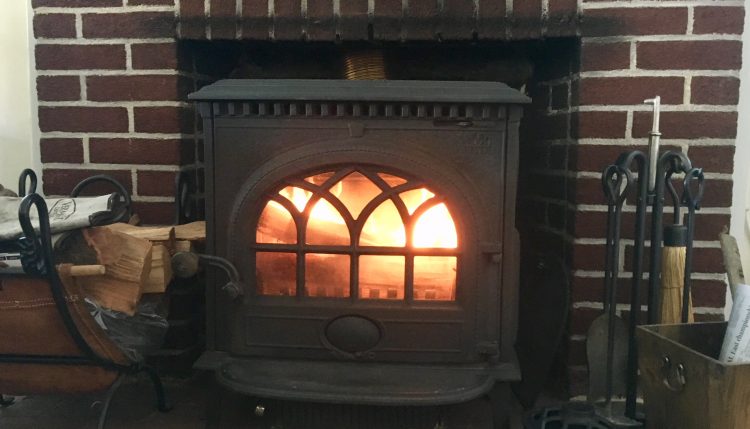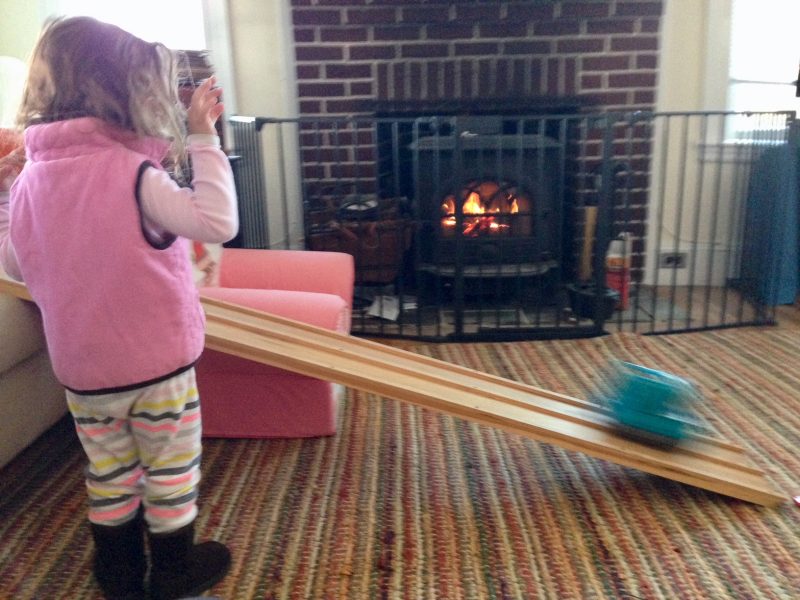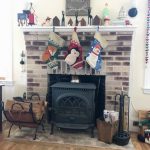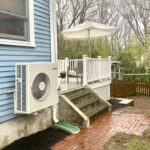Let's be upfront about something: I'm not a big believer in tinkering with classic red brick. It's generally beautiful - perfect, even? - just as it is. My friend Kirk put…

Wood stove or fireplace? It’s no contest.
It’s that time of year, when the weather turns crisp and a young man’s fancy turns to… fire!
When we first bought our house, I was excited about a lot of things — the driveway, for example, after circling for parking in the Back Bay for three years — but none so much as the fireplace. A wood-burning fireplace had been my No. 1 “must have” during our house hunt, and our two-family had a nice brick hearth in each unit.
So before we even closed on the house, I scheduled a cord of seasoned firewood to be delivered — the first week we were living there, in late August. In hindsight, that was wildly unnecessary, and my wife was justly exasperated: It wouldn’t be cold enough to light a fire for weeks, and we already had moving trucks, contractors, and delivery vans coming and going nonstop, along with a mile-long list of things to do. It was a zoo around here and I just added to the considerable chaos in my overzealous excitement. (Also: A full cord is a LOT of wood to get dumped in your yard!)
Anyway, shortly after we got 128 cubic feet of firewood delivered, we had our chimney inspected, since the previous owner hadn’t used the fireplace much. And we got some bad news: It wasn’t even up to 1909 building codes. Typically an older chimney will at least have a clay ceramic liner; ours had nothing at all, just crumbling brick. To get it in shape would cost $5,000 or more. There would be no fires.
Oh, like hell there wouldn’t!
We couldn’t swing that price, but I started looking into other solutions. Four Seasons Chimney suggested installing a stainless steel chimney liner, a cheaper option at about $1,200, which we could then connect to a wood stove tucked into the hearth.
Now, I had never considered a wood stove, and really had my heart set on the warm crackle of a traditional fireplace. But once I started researching these cast iron heat-pumping beasts, it didn’t take long for me to come around.
| I wrote a book! It’s called ‘Home Buying 101: Your Essential Guide to Buying Your First Home‘ and you can get it from Amazon, Bookshop.org, Barnes & Noble, or your local bookstore. |  |
Why I’ve learned to love our wood stove
My brother has always been a fellow pyromaniac, and his home has both a wood stove and a fireplace. So I asked him how he liked the stove — and he like, flipped out with excitement. His enthusiasm for his big Jotul stove could not be tamed. That endorsement was all I needed — and now I feel very much the same way.
We ended up buying a used Jotul F3 — a small-to-medium stove that can heat up to 1,300 square feet — from a guy in New Hampshire who was upgrading to a bigger one to heat his whole house. They sell for about $2,000 new, but we got it for $500 off Craigslist. However, this meant getting a 265-pound iron stove into the back of our little Kia Rio.
After driving around with the thing in the backseat for two weeks — it was too heavy to budge by myself, and made the poor car sag to one side — my brother and cousin Issam then helped me carry it upstairs, which very nearly killed us all.
If you have the means, I would absolutely recommend buying a stove new and getting it delivered professionally. For one thing, if there’s a problem (e.g., a crack in the firebox) with a used one, it’s not an easy item to cart around or return to a seller, and a fault can be deadly. Plus, newer models are more efficient and produce less smoke. At the very least, make sure you’ve got hired help or some of your largest friends or family members ready to help when it’s time to carry the thing into your living room.
Anyway, we’ve had the stove for nine years now, and it’s one of my favorite things about our home. Here’s why, like my brother, I’ve learned to love our wood stove over any fireplace:
It’s more efficient.
A fireplace is toasty and cozy, no doubt. But because it’s wide open, a ton of the warmth just escapes up the chimney. That air flow can also draw in cold air through cracks and windows, because it creates an air current. A traditional fireplace is only about 10% efficient, according to BobVila.com – meaning 90% of the wood’s heat is lost.
With a wood stove, less heat escapes. Most EPA-approved stoves burn wood at about 70% to 75% efficiency. Think about it: The whole cast-iron encasement heats up (to scary high temperatures, mind you — we had a gate around ours during our daughter’s toddler years), and it acts like a powerful radiator, even after the fire’s gone out.
That means it heats our entire home.
Our home is 1,150 square feet, and if we have our small wood stove blazing — and it’s not below, say, 15 degrees Fahrenheit outside — we don’t need to have the heat on, even in our drafty old house. Even when it’s frigid, it has kept our whole home warm enough — hovering in the mid-60s — through blizzard blackouts without any power or heat.
We typically light the stove two or three times per week, giving our boiler a break (and our gas bill, too). We go through about a third to half a cord of wood per winter at that rate; if you’re looking for a good firewood supplier with free delivery in the Boston area, we’ve been really happy with Beech Hill Firewood in Newton, Mass., the past couple of years.
You can leave it going at night.
Because the fire is contained behind a closed glass door, it’s a lot safer – at least in terms of sparks flying out and lighting your house on fire. You can toss a few logs in at the end of the night, close the door, and safely go to bed while the fire keeps burning and heating the house for another few hours.
Yep, it’s official: I’m a wood stove fanatic. I still love the look and feel of a traditional fireplace, and I wouldn’t kick a gas fireplace or stove out of the house either, but there’s nothing so cozy or downright efficient as a good wood burning stove.
What are the drawbacks of wood stoves?
Ok, wood stoves aren’t perfect. As I mentioned, they get VERY HOT (that’s the point), and if you’ve got a stumbly toddler in the home, you’ll want to put a safety gate around it, like so:

Even so, fireplaces are dangerous, too — I’d probably want a gate to keep my little one from falling face first into a roaring fire as well.
Firewood is also HEAVY. This applies to both wood stoves and fireplaces, of course, but it definitely helps makes the case for a gas fireplace if you live on the second floor or simply aren’t inclined to lug heavy logs around all winter.
(An alternative is a pellet stove, which burns tiny nuggets of compressed sawdust. Boston Globe travel editor Chris Morris wrote a wonderful ode to her pellet stove a couple of years ago. “I have three babies,” she said. “Two of them are children. One of them is a pellet stove. I love them all.”)
Another issue applies to wood heat in general. Burning wood to heat your home has some real environmental benefits — namely, unlike oil, gas, or coal, you can grow trees sustainably (and they suck up carbon as they grow). And a modern wood stove, at 75% efficiency, is almost as efficient as many steam boilers or older furnaces.
However, burning wood — even in newer, EPA-certified stoves — releases fine particulates — tiny particles, including some carcinogens, that contribute to smog and cause health problems like asthma. (Older stoves are generally worse about this, as are open fires.)
Double however: We got an air quality monitor last winter, and we tested the air in the living room and directly above the stove on the mantel while a fire was burning — and it was perfectly ok, with green smiley faces on the monitor. (The real culprit in our house turned out to be the gas stove. We don’t have a vented range hood, so testing the air in our kitchen while I cooked on the stove resulted in truly unhealthy levels of carbon monoxide, Formaldehyde, fine particulates, and other bad stuff. All red frowning faces on the monitor, yikes! Stay tuned for an entry on installing range hoods or induction stoves I guess!)
Tips for cleaner, safer burning
To minimize this risk, the New Hampshire Department of Environmental Services makes a few recommendations:
Choose an efficient stove.
Smoke (which contains those harmful fine particulates) is caused by incomplete combustion. You want as much of the wood to burn up completely as possible, in the form of flame, and to see very little smoke coming out of your chimney, if any. All EPA-approved stoves achieve that in one of two ways.
There are two main types of wood stoves. Our stove is a non-catalytic model, as are most EPA-approved Jotuls, and I’d recommend that — it’s simpler and requires far less (almost zero) maintenance. Essentially, it’s a mechanical design: The way the stove is built, air flows a certain way to ensure that more wood burns. Catalytic stoves, on the other hand, tend to be higher-end. They do burn more evenly and a bit more efficiently, but you need to replace the catalyst every few years. I can barely remember to get my oil changed, so that’s not for me!
Burn dry, seasoned hardwood.
Burning wet, fresh-cut (“green”) wood, or soft wood like pine will reduce efficiency, since the fire is working too hard just to evaporate the water in the wood. Use hardwood (maple, oak, beech, birch, elm, ash) and let it air-dry in the sun for a whole season, and store it covered. Better yet, spring for kiln-dried firewood, which has been dried in an oven and can even be stored indoors because there are no bugs in it. It’s more expensive, but because it’s nothing but solid wood, kiln-dried firewood burns incredibly efficiently – meaning you don’t need to use as much of it.
Burn hot.
Contrary to all those pictures you drew as a kid, you actually don’t want to see smoke coming out of your chimney. Make sure the fire has plenty of oxygen — this means leaving space between logs for air and flames to flow.
A hotter fire means less smoke, and less creosote, too — the stuff that can cling to your chimney liner and cause a fire. “Never allow the fire to smolder,” says the NH DES. “Smoldering fires are the worst polluters because they burn at a temperature too low for efficient combustion. The result is more smoke – unburned wood going up the chimney, wasted. This means more air pollution and creosote deposits that could lead to a chimney fire.”
Only burn wood.
Listen, I know how tempting it can be to throw things into a fire. It burns right up in a blaze of glory! I may have even watched a Curtis Martin Patriots jersey go up in flames after he signed with the New York Jets many years ago. But resist the urge to toss things into the fire. Burning garbage, magazines, any kind of plastic, or really anything that’s not firewood is terrible for the environment and your health.
And, I’d add, don’t overlook alternatives.
We now have solar panels on our house, so an environmentally friendly alternative would be to use an electric “wood stove” — essentially a space heater that looks like an old-fashioned stove — powered by those solar panels.
I would have balked at that at one point — I love the smell of a wood fire, the process of loading and lighting it, the authenticity and primitive nature of it all.
But we bought an electric wood stove for our downstairs apartment (this model, for about $100), and when we were living down there in exile during our bathroom remodel, I’ll tell you what: It was cozy as hell, and all you have to do is flip the switch. (If you buy that Duraflame model on Amazon, don’t bother paying extra for the “expert installation.” It’s literally just a nice glowing space heater: You screw on the legs and plug the thing in.)
Buying and maintaining a wood stove
If you do buy a wood stove, make sure you get the right size for your space. You don’t need – or want – a giant stove in a small space, because you’ll be sweating it’ll get so hot. Plus you’ll go through more wood than is necessary.
You also want to ensure you have the right setup: You need a proper chimney — one that goes up past the top of your house (one benefit of a gas fireplace or stove is that it can vent straight out the side of your wall) — and a liner that fits the opening of the stove (generally 6-8 inches, but check to be sure). You should have a hearth around it — in fact, your home insurance will generally require you to have at least 12 to 18 inches of brick or other nonflammable material surrounding the opening.
Learn to use the various draft settings on your stove, which you can find in the manual or at the manufacturer’s website. Ours has two draft levers: One, on the bottom, is for when you’re first starting a fire — it lets in a lot of air to help it get started. After about 30 minutes or so, you switch it back to normal, otherwise the fire will keep going at a crazy clip. And then a separate lever on the top of the stove is for fine-tuning the air flow — you can dial it back so the logs burn a little longer, which is good at night.
Never throw ashes in the trash, even after a day or two. This is how houses get burned down all the time — hot embers can hang out in a pile of old ashes for quite awhile and are all too ready to torch those CVS receipts in your garbage. If your stove doesn’t have an ash receptacle, store them in a metal bucket near the fire until they’re good and cooled off. Ashes are basic, so you can actually spread them on your lawn as a substitute for lime if you have acidic soil.
Finally, three more random wood stove tips:
1. If the glass gets smeared up with soot or creosote, you can just clean it with vinegar, it comes off easily. (Hopefully this is obvious, but don’t do this while a fire is burning or while the glass is still hot.)
2. You can make your cast-iron stove look basically brand new for 10 bucks in about 10 minutes using Williams Stove Polish. (There are other brands out there, but this is the one I used and it’s nothing short of a miracle.)
You just rub it on with a rag (one you don’t plan on needing again), let it dry for a few minutes, and then wipe off any excess, and your stove will look jet black again, even in rusty spots. It doesn’t smell when you light your next fire, or contain any weird stuff or anything – I’m telling you, it’s a miracle!

3. The Inflation Reduction Act established some pretty nice incentives to invest in biomass heating equipment, including a 30% tax credit (up to $2,000 annually) on the purchase and installation on wood and pellet stoves, as long as they’re EPA-certified at 75% efficient or better. Same goes for pellet-stove boilers, which you see more often in Maine and Vermont. (Here’s a handy explainer from the Hearth, Patio, and Barbecue Association, which is a real thing, somehow!)
Some New England states offer their own wood or pellet stove incentives, too. For example, in Vermont, you can get a $400 instant rebate if you switch out a smokey old stove for a newer EPA-approved model. Many of the most efficient models are catalytic stoves, but some non-catalytic models qualify as well, such as the Vermont Castings C3. And in Maine, you can get a 33% rebate, up to $6,000, on the installation of a wood- or pellet-stove boiler.
Time to get cozy by the fire. Happy burning!
(We’ve since whitewashed that brick fireplace hearth – see how it came out here.)



